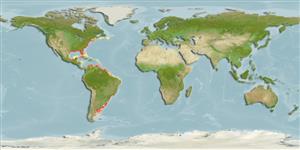Actinopterygii (ray-finned fishes) >
Perciformes (Perch-likes) >
Sciaenidae (Drums or croakers)
Etymology: Pogonias: Greek, pogon = beard (Ref. 45335).
Environment / Climate / Range
Ecology
Marine; brackish; demersal; oceanodromous (Ref. 51243); depth range 10 - ? m. Subtropical, preferred 23°C (Ref. 107945); 46°N - 51°S
Western Atlantic: Nova Scotia (Ref. 7251) to Florida, Gulf of Mexico, the Antilles (uncommon), and the southern Caribbean coast; also from the Orinoco delta to Argentina.
Length at first maturity / Size / Weight / Age
Maturity: Lm 64.5, range 63 - ? cm
Max length : 170 cm TL male/unsexed; (Ref. 7251); common length : 50.0 cm TL male/unsexed; (Ref. 3702); max. published weight: 51.3 kg (Ref. 4699); max. reported age: 43 years (Ref. 7188)
Dorsal
spines
(total): 11;
Dorsal
soft rays
(total): 19-22;
Anal
spines: 2;
Anal
soft rays: 5 - 7. Silvery grey to very dark, young with 4 or 5 black vertical bars on sides, disappearing with growth; pelvic and anal fins usually dark. Chin with 5 pores and 10 to 13 pairs of small barbels along median edges of lower jaws and subopercles, increasing in length posteriorly. Gas bladder with numerous lateral appendages interconnected in a complicated pattern in adult. Sagitta semicircular and moderately thin (Ref 51721).
Found usually over sand and sandy mud bottoms in coastal waters, especially in areas with large river runoffs. Juveniles often enter estuaries. Feeds mainly on crustaceans, mollusks and fishes.
Robins, C.R. and G.C. Ray, 1986. A field guide to Atlantic coast fishes of North America. Houghton Mifflin Company, Boston, U.S.A. 354 p. (Ref. 7251)
IUCN Red List Status (Ref. 115185)
CITES (Ref. 94142)
Not Evaluated
Threat to humans
Harmless
Human uses
Fisheries: commercial; gamefish: yes; aquarium: public aquariums
More information
ReferencesAquacultureAquaculture profileStrainsGeneticsAllele frequenciesHeritabilityDiseasesProcessingMass conversion
Tools
Special reports
Download XML
Internet sources
Estimates of some properties based on models
Phylogenetic diversity index (Ref.
82805): PD
50 = 1.0000 [Uniqueness, from 0.5 = low to 2.0 = high].
Bayesian length-weight: a=0.00832 (0.00741 - 0.00933), b=3.08 (3.05 - 3.11), in cm Total Length, based on LWR estimates for this species (Ref.
93245).
Trophic Level (Ref.
69278): 3.4 ±0.5 se; Based on diet studies.
Resilience (Ref.
69278): Medium, minimum population doubling time 1.4 - 4.4 years (K=0.17; tm=3-5; tmax=43).
Prior r = 0.27, 2 SD range = 0.17 - 0.42, log(r) = -1.31, SD log(r) = 0.22, Based on: 3 K, 2 tgen, 2 tmax, records
Vulnerability (Ref.
59153): High vulnerability (60 of 100) .
